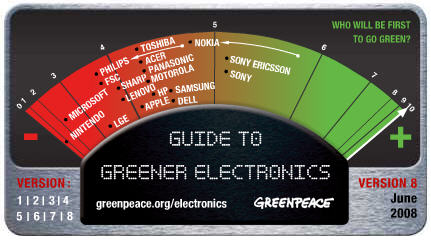
When software giant Microsoft characterizes its environmental efforts as "still in the first inning," as its new Chief Environmental Strategist, Rob Bernard recently did, you know that the information technology industry (IT) has a long way to go towards becoming more sustainable.
Just think about the environmental cost of Google's famous cloud computing. Data center computers and servers alone used 61 million megawatt hours of electricity in 2006, according to an Environmental Protection Agency (EPA) Datacenter Report submitted to the U.S Congress last summer . That's at least 1.5% of all U.S. electricity and double the amount consumed in 2000.
To tackle energy consumption from personal computers (PCs), an industry partnership has been recently established. Intel, Google, Lenovo and the World Wildlife Fund (WWF), an environmental nonprofit that tends to partner with corporations, have launched the Climate Savers Computing Initiative. Goals include sharing green computing tips to consumers, along with a 50 percent efficiency target for future PCs which would reduce greenhouse gas emissions by 54 million tons per year and save $5.5 billion in energy costs.
Today, however, there is still no widely understood standard for greener PCs. If you wander into Best Buy and ask a sales rep for the greenest personal computer, you are going to be met with a blank stare.
It is unreasonable to expect that most people have the patience to collect and wade through the environmental data before shopping for a new machine. Many enterprises now have an entire staff dedicated to tackling the energy use and electronic waste of their office computers and data servers. Yet resources and clear fact-sheets for environmentally-conscious PC customers are still relatively limited.
The EPA has attempted to solve this issue by funding a scheme, called the Electronic Products Environmental Assessment Tool (EPEAT), which ranks PCs on a tiered system similar to the LEED ratings for green buildings. Environmental attributes include Energy Star ratings, packaging and durability and electronic waste reductions. Although major purchasers such as the Federal government now mandate buying EPEAT-certified computers, good luck finding this information at your local retailer.
That isn't to say that PC firms are idling on the green messaging. Dell caused ripples in the IT world and green blogosphere when a May press release took a direct shot at rival HP's green credentials. HP's camp responded over a phone conversation with me that they let their long environmental track record speak for itself.
Nonetheless, GreenPeace's 'Guide to Greener Electronics,' suggests that neither firm is particularly green just yet.

In reality, while PC firms do seem to be tackling energy issues (at least in regards to the operating energy efficiencies of their products; most computer companies take no responsibility for the greenhouse gases emitted by third party vendors along their global manufacturing supply chains), they still need to reduce toxic components and improve their recycling programs. The EPA estimates that electronic waste accounts for two percent of the total municipal solid waste stream. Shockingly, there are more than 1,000 toxic chemicals used during electronics production. And PC companies have been reluctant to change their ways and take ownership of the solutions.
For example, Greenpeace was so stunned by Apple's refusal to eliminate toxic flame retardants, and polyvinyl chloride from its computers that it launched an entire online campaign called Green My Apple. Apple has finally responded with the "We were always green but we just weren't sharing it" argument, and has gone on to claim it is actually ahead of HP, Dell and Lenovo on many green metrics.
Clearly, the IT industry is just starting to figure out how to go green and communicate its efforts with its customers. Now is the time for consumers to ask tough questions to PC companies and their retailers. Dell, at least, has created a website to solicit feedback on these issues called IdeaStorm. As demand for greener computing grows, hopefully the green marketing confusion will subside and true sustainability innovators will be rewarded.
In the meantime, make sure that you properly recycle your old machines when you decide to upgrade. The EPA has put together a handy list of take-back options. Often, you can donate old electronics and actually get cash donated to a nonprofit of your choice.